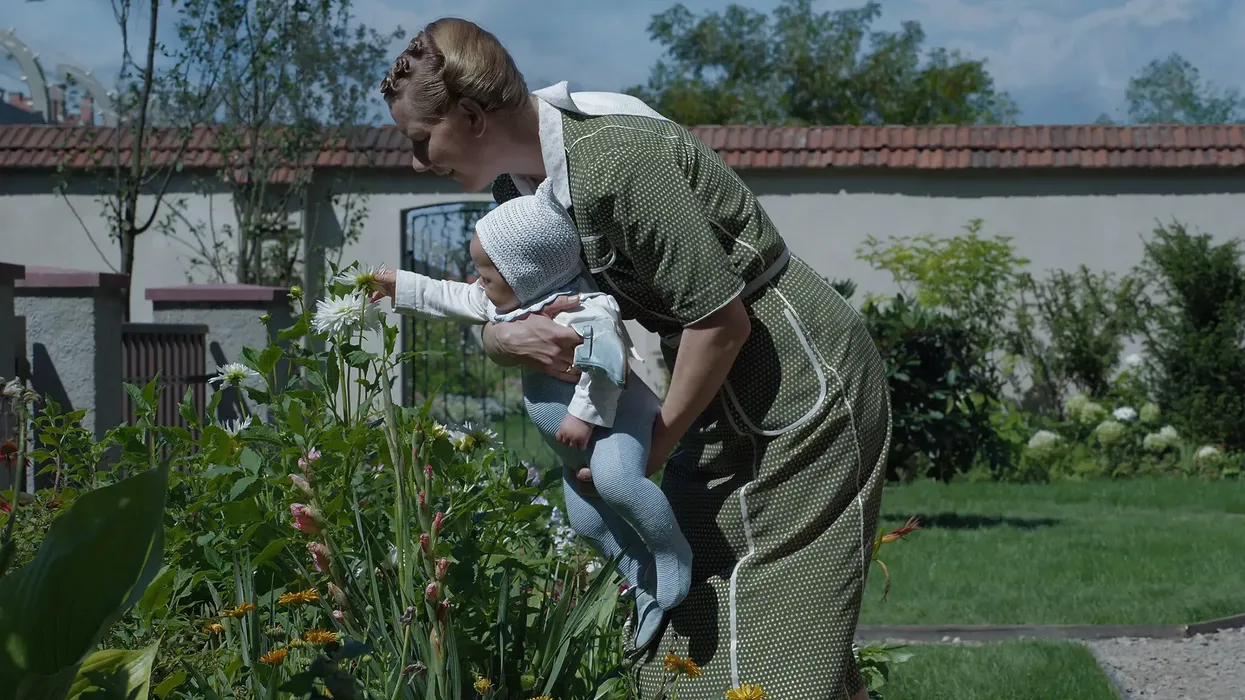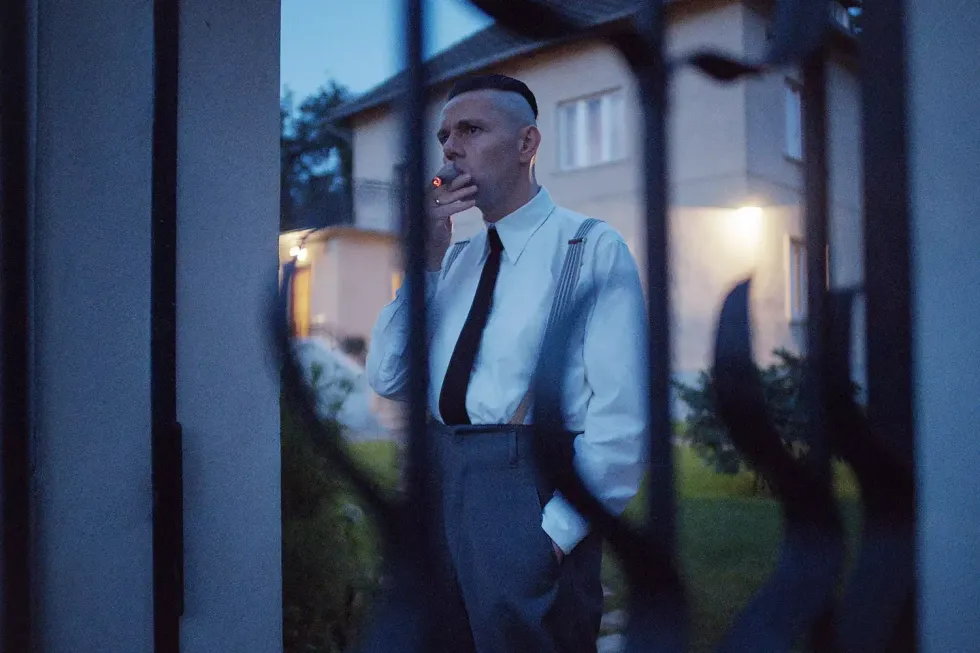We Speak to the Oscar-Nominated Sound Designer of 'The Zone of Interest'
Johnnie Burn shares a wealth of knowledge from one of 2023's best films, The Zone of Interest.

Sandra Hüller in 'The Zone of Interest,' directed by Jonathan Glazer.
There is no denying that Jonathan Glazer's film The Zone of Interest is one of last year's most harrowing and impactful films.
The movie is essentially a family drama—however, this family is fascist, and their home is on the edge of Auschwitz, and their patriarch is commandant Rudolf Höss, the head of the concentration camp. The Zone of Interestis cinema at its most gripping and timely, a horror story of evil told through a family's everyday, boring activities.
The camp itself is never shown, only heard, the horrors witnessed at an objective but gut-wrenching distance.
This is why sound designer Johnnie Burn's work on the film is so important to the story it tells obliquely, through screams, gunshots, and an ever-present rumble. It's also why the sound design has been honored with a much-deserved Oscar nomination.
We were honored to be able to speak with Burn via Zoom about his research process on the film, how sound was captured on set, and his best advice for aspiring sound designers. Enjoy this wealth of knowledge from one of the year's best.
The Zone of Interest | Official Trailer HD | A24www.youtube.com
Editor's note: The following interview is edited for length and clarity.
No Film School: I think this film is so stunning, and what you did with the sound as part of the storytelling is so incredible. Where do you even start on a project where sound is so important?
Johnnie Burn: By becoming an expert on sound in Auschwitz. Jon [Glazer] handed me the script a year or so before filming and said, "I don't know how we're going to do it, but you're going to figure it out." And he said, "I'm going to go and film a family drama, and I'll see you in about a year. And in the meantime, you need to know what you've got to know and you've got great responsibility because the film needs the sound to work."
And at that point, he said, "Read the script." It doesn't say anything other than, at the beginning, "We will hear the sound of the camp in this film," and that was it, because we didn't know what that would be ... Yeah, "We'll need to figure out what that is. And you've got a year."
So that was the brief.
NFS: I read that you came up with a 600-page bible and were very particular about the locations of different sounds. What was that research process like?
Burn: Yeah, so literally, become an expert on sound in Auschwitz and be able to reproduce, to me, in about a year's time, what it sounded like. For me, was, "Right, okay, so research." And I began online and reading Primo Levi, and there's a lot that's available.
But we also had access to the Auschwitz Memorial archive. It was hugely useful, and I knew that I had to do the normal stuff that a sound designer would do by understanding the birds and the bees that would be there and the motorbikes that go past on the road.
But really, obviously, the poignant bit was understanding witness testimony and understanding how the murders took place and being able to reproduce that faithfully and with respect to the survivors and the victims.
That was about reading everything I could. And there's much testimony that does allude directly to sound, like the sound of the electric fence and how it sounded like it screamed, and how it made a particular noise when people would choose to end their life by throwing themselves in it.
There's all sorts of specific things that I cataloged, but the bulk of it was just reading about stories and people's experience there and basically copying and pasting that into my document, but using each one of those as a mini script that I should go and make a sort of, I suppose, radio play kind of thing out of it. So that, in the year interim, before I kind of got back into a room with Jon again, I would have hundreds of different, "Here's how I think this went down ..."
So a lot of gruesome reading and a lot of understanding and a lot of cataloging that into the document, and then, making a map, a big map, that was based on the photograph from Google Images, but all with specific distances and understanding how sound decays over time and how the tonality so that you lose the bass and the top end of a sound incident, and all the reflective surfaces. So I could model the reverb patterns of reflections of any gunshot.
And understanding the block nearest the house was the guard's house. And so, understanding that the witness testimony of all of that was more to do with occasionally drunken behavior in the evenings and abuse of prisoners in that.Then, that the block just beyond that was the French prisoners' block and that, particularly during the period of time that the film was set, there were a lot of French arrivals.
So just understanding where things should come from and how they should sound and at what volume, and so, that I could approach it with primarily science over art, so that, initially, so that I could stand by it and say to the director, "This is what I think happened."

NFS: How many sounds were you working with, in any one scene, how many layers?
Burn: It depends, because if you really break it down, in some of the scenes, when you'd have an awful lot of screaming, it would be hundreds. The project had about 3,000 layers of sound overall ... because at one point, we had music on it, and then we took that off.
There was always the sound of the house. ... The house was a lovely family drama, and normally, on a film set, you want to record the sound of the dialogue, of the actors talking, and that's the primary job of the sound recordist. And here, everything's in mid-shot, and Jon wanted to keep a critical distance, so that we could observe rather than be in amongst.
And even that extended to the actors, "Don't try and become. Just be." And so, it was all about, "Observe people in the house," and that extended to the film. [It] was shot with multiple scenes happening at the same time.
Everything you see, where you imagine it's all happening at the same time, it actually was. And the takes were an hour long, because that was the length of the memory stick. And there were 10 hidden cameras, and we had budget for 20 microphones, but we had 50 microphone positions.
On any scene, I would have 20 tracks of audio from all the different mics around the house. So if the kids screamed and then ran out the house and went around the outside wall, I could still keep the sound of them going as they walked past Rudolf's office, where he's sitting with the men and talking about the crematoria. So many layers from the house, but then, a layer of foley that we recorded in the actual house to augment the teacups rattling and the footsteps and the locking of the doors.
And we actually went to the formal completed process ... we made the family drama, the "Big Brother" thing, as a film in about a year and did the picture edit. And then Jon and I sat down and said, "Right."
Because the people in the house obviously didn't hear anything, so we shouldn't start putting gunshots on until we finished making their world. So we did that, and then it was another five or six months of augmenting with the other layers, to answer your question of how many layers.
And so, there was always the constant sound of the camp, which it was an interesting development later on. And there was always voices and armaments and passing cars and airplanes and the wind and the insects in the house and all the different rooms within the house and the camp orchestra. So yeah, I didn't answer your question, but I almost did.
NFS: No, you did. That's amazing. I honestly could talk about this for hours and hours. Your work is so integral, but often unnoticed.
Burn: My mother once said to me, "What do you mean, you do the sound on films? They sound all right to me." And were she still alive, she'd probably understand on this one, that sound can actually be something different.
NFS: What mistakes do you see beginning sound designers make that you would advise they avoid?
Burn: It's an easy one. I spent my whole of my early years trying to cram in, "This is a cool sound. That's a cool plugin." It's not about any of that.
With regards to plugins, it's about just finding a good recording of something and know a couple of plugins and know them well. But you don't need a lot. You really don't.
And it's absolutely primarily about being a filmmaker and sitting with the director's hat on and imagining how he wants this film to go and being the filmmaker who happens to be wearing the sound hat. And that helps you lose your ego of, "But I made ... " Because you could spend weeks making some amazing thing, and you'll try and push it on a director, who now you're going to have an awkward conversation, because it's obvious to everyone except for you that it doesn't belong in the film. So yeah, be a filmmaker before you are a sound person.
NFS: That's great advice. Is there anything that you wanted to mention, in terms of advice or anything that I didn't ask about?
Burn: I think, for me, I always keep that as a central tenet, and then I think audiences are more aware of soundscapes. Films always used to be, "Here's the music, here's the dialogue, pull focus on the sound."
Whereas I think audiences now are so much more adept to understanding nuance in a soundscape, so we can make more complex soundscapes and expect an audience to understand the narrative beats that live in them. ... Credit the audience with intelligence.

 "'Back Home"via Mercedes Arutro
"'Back Home"via Mercedes Arutro 'Back Home'via Mercedes Arutro
'Back Home'via Mercedes Arutro 









